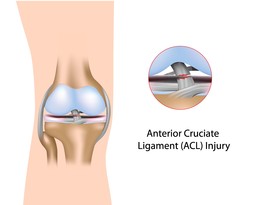

What is the anterior cruciate ligament?
The ACL (anterior cruciate ligament) is one of the four major ligaments that helps to stabilize and support the knee. The ACL works along with the PCL (posterior cruciate ligament) and the medial and lateral collateral ligaments (on the sides of your knee) to stabilize the knee joint. The ACL prevents the tibia (shin bone) from moving too far forward on the femur (thigh bone) and limits rotational movement of the knee.
 What is an anterior cruciate ligament injury?
What is an anterior cruciate ligament injury?
An ACL injury results from overstretching or tearing this ligament. Immediately after an ACL injury, your knee may swell, feel unstable, and become too painful to bear weight. Many people report that they feel a “popping sensation” in their knee when this type of injury occurs.
What are common causes of an anterior cruciate ligament injury?
The ACL can be injured in several different ways. Causes of injuries can include changing direction quickly, landing incorrectly from a jump, direct contact from a collision, or stopping suddenly. Movements of the knee that result in a tear are often described as a hyperextension injury (the knee straightens beyond its normal fully straightened position) or a pivoting injury (excessive inward turning of the lower leg).
Diagnosis
A physical examination and patient history with a qualified musculoskeletal expert is the first step. A physician will compare a patient’s non-injured knee with the injured knee. Most injured ligaments can be diagnosed after an examination using special manual tests. Imaging tests such as MRI or X-rays may be needed to see if there are additional injuries such as broken bones or additional tissue injuries (muscle, tendons, ligaments, or cartilage).
Common Treatment
There are both non-surgical and surgical options available. Non-surgical treatment could be effective for patients that have a low activity level or who are elderly.
Rehabilitation
After surgery, you will use crutches or a walker at first. You will gradually increase the amount of weight you can put on your repaired leg. You will likely be wearing a brace to give you support while the knee is healing and regaining strength. You may initially have a machine that moves your leg to help you progress with range of motion. Physical therapy will be a very important part of your recovery. A physical therapist will guide you in many stretches and exercises to help you restore your range of motion, strength and stability.
Copyright © www.orthopaedics.win Bone Health All Rights Reserved